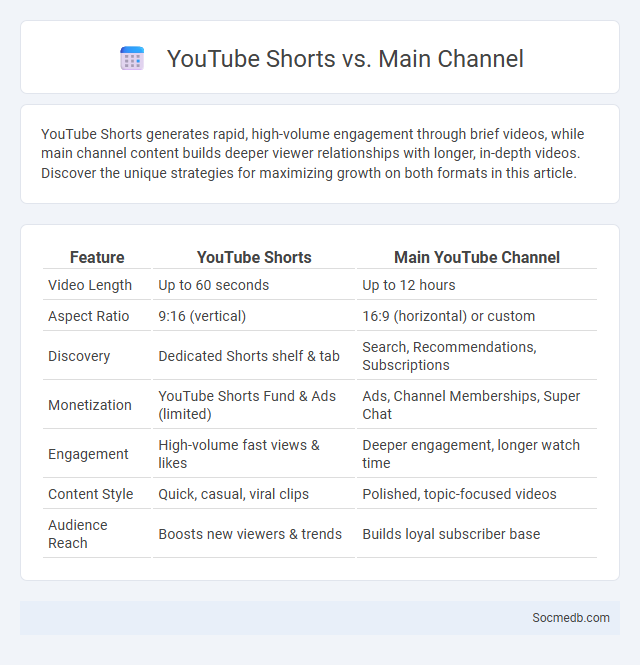
Photo illustration: YouTube Shorts vs Main Channel
YouTube Shorts generates rapid, high-volume engagement through brief videos, while main channel content builds deeper viewer relationships with longer, in-depth videos. Discover the unique strategies for maximizing growth on both formats in this article.
Table of Comparison
| Feature | YouTube Shorts | Main YouTube Channel |
|---|---|---|
| Video Length | Up to 60 seconds | Up to 12 hours |
| Aspect Ratio | 9:16 (vertical) | 16:9 (horizontal) or custom |
| Discovery | Dedicated Shorts shelf & tab | Search, Recommendations, Subscriptions |
| Monetization | YouTube Shorts Fund & Ads (limited) | Ads, Channel Memberships, Super Chat |
| Engagement | High-volume fast views & likes | Deeper engagement, longer watch time |
| Content Style | Quick, casual, viral clips | Polished, topic-focused videos |
| Audience Reach | Boosts new viewers & trends | Builds loyal subscriber base |
Understanding YouTube Shorts: A Quick Overview
YouTube Shorts are vertical, short-form videos lasting up to 60 seconds designed to capture quick, engaging content for mobile users. This format leverages YouTube's vast user base, enabling creators to reach broad audiences through rapid, digestible clips. Optimizing YouTube Shorts involves using trending music, sharp visuals, and concise messaging to maximize viewer retention and engagement.
Main Channel Videos: Features and Strengths
Main channel videos on social media platforms offer high engagement through rich visual and auditory content, making them ideal for storytelling and brand promotion. Features such as live streaming, video analytics, and interactive elements like polls enhance viewer interaction and retention. Strengths include broad reach across demographics, algorithm-driven visibility boosts, and the ability to convey complex messages efficiently in a concise format.
What Sets Shorts Apart from Main Videos?
Shorts are designed for vertical, bite-sized content that captures attention within seconds, typically lasting up to 60 seconds, unlike main videos that can be longer and more detailed. The algorithm prioritizes Shorts for their rapid consumption and high engagement, often appearing on dedicated feeds and receiving enhanced visibility. This format encourages creativity through trends, challenges, and easily shareable clips, distinguishing it from traditional video content focused on in-depth storytelling.
Content Length and Format Comparison
Content length significantly impacts engagement on social media platforms, with short-form videos under 60 seconds gaining the highest completion rates on TikTok and Instagram Reels. In contrast, LinkedIn and Facebook post longer articles or videos, averaging 1,200 words and 3-10 minutes, which cater to professional and detailed storytelling. Visual formats such as infographics perform best for Twitter, combining brevity with high informational value to maximize shareability and user interaction.
Algorithm and Discovery: Shorts vs Main Channel
Social media algorithms prioritize personalized content discovery by analyzing user behavior, engagement, and preferences to optimize video visibility on platforms like YouTube Shorts versus the main channel. Shorts utilize a vertical, short-form video format designed to boost rapid consumption and viral potential, leveraging an algorithm that favors watch time and repeat views. The main channel algorithm emphasizes longer engagement through diverse content recommendations, audience retention, and subscriber interaction metrics, influencing video ranking and discoverability.
Monetization Differences Between Shorts and Main Videos
Monetization differences between YouTube Shorts and main videos lie primarily in ad revenue potential and viewer engagement metrics. Traditional main videos benefit from longer watch times, enabling creators to earn higher ad revenue through mid-roll ads and premium placements. Shorts generate revenue through the Shorts Fund and increased channel subscriptions but typically yield lower direct ad income due to their brief format and limited ad integration.
Audience Engagement: Shorts vs Main Channel Content
Audience engagement on social media varies significantly between shorts and main channel content, with shorts typically generating higher view counts and quicker interactions due to their brief, attention-grabbing format. Main channel content, often longer and more in-depth, fosters deeper connections and sustained engagement through storytelling and comprehensive topics. Brands leveraging both formats can maximize reach and engagement by targeting different audience behaviors and preferences.
Best Practices for Creating YouTube Shorts
Creating YouTube Shorts requires concise, engaging content that captures attention within the first few seconds. Use vertical video format with a maximum length of 60 seconds, incorporate trending music and hashtags, and add clear captions to improve accessibility and reach. To boost your channel's growth, prioritize consistent posting schedules and interact with your audience through comments and community features.
When to Use Shorts Instead of Main Channel Videos
Shorts are ideal for capturing quick attention with engaging, bite-sized content under 60 seconds, perfect for trends, challenges, or teasers that boost visibility and reach on platforms like YouTube and Instagram. Use main channel videos for in-depth storytelling, tutorials, or comprehensive reviews that require longer engagement and higher production quality to build stronger viewer connections. Prioritize Shorts to enhance discoverability through algorithm-driven feeds, while reserving main videos for detailed content that supports brand authority and subscriber retention.
Choosing the Right Format for Your YouTube Strategy
Selecting the right video format tailored to your YouTube strategy significantly influences viewer engagement and retention rates. Understanding audience preferences, such as tutorials, vlogs, or live streams, allows you to optimize content delivery and boost channel growth. Your YouTube success depends on aligning format choices with your niche and business goals for maximum impact.
 socmedb.com
socmedb.com